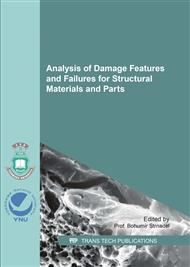[1]
J. Banhart, Manufacture, characterisation and application of cellular metals and metal foams, Prog. Mater. Sci., 46 (2001) 559-632.
DOI: 10.1016/s0079-6425(00)00002-5
Google Scholar
[2]
J. Banhart, Aluminium foams for lighter vehicles, Int. J. Veh. Des., 37 (2005) 114-125.
Google Scholar
[3]
F. García-Moreno, Commercial Applications of Metal Foams: Their Properties and Production, Materials, 9 (2016) 85.
Google Scholar
[4]
A. Pollien, Y. Conde, L. Pambaguian, A. Mortensen, Graded open-cell aluminium foam core sandwich beams, Mater. Sci. Eng. A, 404 (2005) 9-18.
DOI: 10.1016/j.msea.2005.05.096
Google Scholar
[5]
A.H. Brothers, D.C. Dunand, Density-graded cellular aluminum, Adv. Eng. Mater., 8 (2006) 805-809.
DOI: 10.1002/adem.200600074
Google Scholar
[6]
A. Hassani, A. Habibolahzadeh, H. Bafti, Production of graded aluminum foams via powder space holder technique, Mater. Des., 40 (2012) 510-515.
DOI: 10.1016/j.matdes.2012.04.024
Google Scholar
[7]
Y. Hangai, T. Morita, S. Koyama, O. Kuwazuru, N. Yoshikawa, Functionally Graded Aluminum Foam Fabricated by Friction Powder Sintering Process with Traversing Tool, J. Mater. Eng. Perform., 25 (2016) 3691-3696.
DOI: 10.1007/s11665-016-2218-x
Google Scholar
[8]
R. Suzuki, K. Kitazono, Effect of Graded Pore Distribution on Thermal Insulation of Metal Foam, J. Japan Inst. Metals, 72 (2008) 758-762.
DOI: 10.2320/jinstmet.72.758
Google Scholar
[9]
Y. Hangai, K. Takahashi, T. Utsunomiya, S. Kitahara, O. Kuwazuru, N. Yoshikawa, Fabrication of functionally graded aluminum foam using aluminum alloy die castings by friction stir processing, Mater. Sci. Eng. A, 534 (2012) 716-719.
DOI: 10.1016/j.msea.2011.11.100
Google Scholar
[10]
Y. Hangai, K. Takahashi, R. Yamaguchi, T. Utsunomiya, S. Kitahara, O. Kuwazuru, N. Yoshikawa, Nondestructive observation of pore structure deformation behavior of functionally graded aluminum foam by X-ray computed tomography, Mater. Sci. Eng. A, 556 (2012).
DOI: 10.1016/j.msea.2012.07.047
Google Scholar
[11]
S. -Y. He, Y. Zhang, G. Dai, J. -Q. Jiang, Preparation of density-graded aluminum foam, Mater. Sci. Eng. A, 618 (2014) 496-499.
DOI: 10.1016/j.msea.2014.08.087
Google Scholar
[12]
Y. Hangai, K. Saito, T. Utsunomiya, O. Kuwazuru, N. Yoshikawa, Fabrication and compression properties of functionally graded foam with uniform pore structures consisting of dissimilar A1050 and A6061 aluminum alloys, Mater. Sci. Eng. A, 613 (2014).
DOI: 10.1016/j.msea.2014.06.039
Google Scholar
[13]
Y. Hangai, N. Kubota, T. Utsunomiya, H. Kawashima, O. Kuwazuru, N. Yoshikawa, Drop weight impact behavior of functionally graded aluminum foam consisting of A1050 and A6061 aluminum alloys, Mater. Sci. Eng. A, 639 (2015) 597-603.
DOI: 10.1016/j.msea.2015.05.007
Google Scholar
[14]
Y.Y. Zhao, D.X. Sun, A novel sintering-dissolution process for manufacturing Al foams, Scr. Mater., 44 (2001) 105-110.
DOI: 10.1016/s1359-6462(00)00548-0
Google Scholar
[15]
M. Hakamada, Y. Yamada, T. Nomura, Y.Q. Chen, H. Kusuda, M. Mabuchi, Fabrication of porous aluminum by spacer method consisting of spark plasma sintering and sodium chloride dissolution, Mater. Trans., 46 (2005) 2624-2628.
DOI: 10.2320/matertrans.46.2624
Google Scholar
[16]
M. Hakamada, T. Kuromura, Y. Chino, Y. Yamada, Y. Chen, H. Kusuda, M. Mabuchi, Monotonic and cyclic compressive properties of porous aluminum fabricated by spacer method, Mater. Sci. Eng. A, 459 (2007) 286-293.
DOI: 10.1016/j.msea.2007.03.027
Google Scholar
[17]
Y. Hangai, H. Yoshida, R. Yamaguchi, O. Kuwazuru, N. Yoshikawa, Relationship between amount of residual NaCl and compressive properties of porous Al/NaCl composites fabricated by sintering and dissolution process, Mater. Trans., 54 (2013).
DOI: 10.2320/matertrans.m2013023
Google Scholar
[18]
Y. Hangai, K. Zushida, O. Kuwazuru, N. Yoshikawa, Functionally Graded Al Foam Fabricated by Sintering and Dissolution Process with Remaining Spacers, Mater. Trans., 57 (2016) 748-750.
DOI: 10.2320/matertrans.m2015404
Google Scholar
[19]
JIS-H-7902, Method for compressive test of porous metals, Japanese Standards Association, (2008).
Google Scholar


